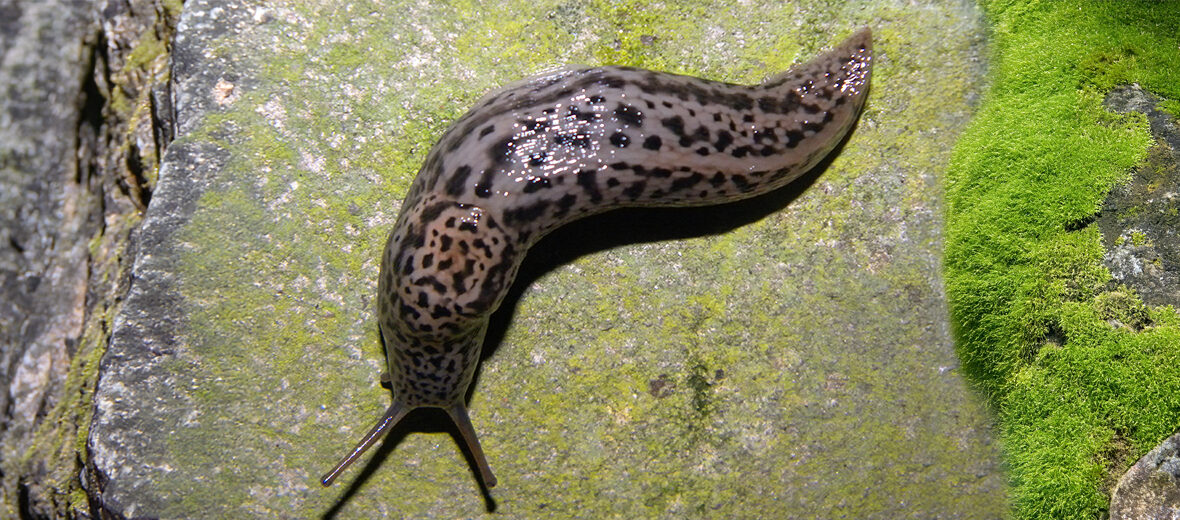
The leopard slug, aka great grey slug, is among the largest of the terrestrial keeled slugs, with the ash-black slug being #1. They hail originally from Europe but have been accidentally introduced to various other countries around the world. With a stable and growing population and a large distribution, these slugs are listed as Least Concern by the IUCN. Sans poisoning, these slugs don’t face any additional threats.
First the Stats…
Scientific name: Limax maximus
Weight: Up to 3+ ounces
Length: Up to 8 inches
Lifespan: Up to 3 years
Now on to the Facts!
1.) Their scientific name literally translates to “biggest slug”.
2.) The mucus of these slugs is colorless and iridescent, and isn’t too adhesive.
3.) The shell of these slugs is reduced in size and internal, under the shield. The occurrence of this internal shell was known of by Pliny the Elder; the shell was also used by ancient physicians for its carbonate of lime.
4.) These slugs are widely distributed throughout the world.
5.) Like many other slugs, they are nocturnal (active at night).
But wait, there’s more on the leopard slug!
6.) When irritated or alarmed, they retract their head and expand their shield.
7.) They are named for their characteristic dark spots and blotches on a background color that is typically grey or greyish-brown, resembling a leopard’s coat.
Did you know…?
They are capable of associative learning, specifically classical conditioning, because they are capable of aversion learning as well as other types of learning. These slugs can also detect deficiencies in a nutritionally incomplete diet if the essential amino acid methionine is removed from their food.
8.) Their homing instinct is strong, and after a night of foraging, they are able to find and return to their original place of hiding.
9.) Leopard slugs are almost always found near human habitations. Typically among cellars, gardens, lawns, and in other damp locations.
10.) They are detrivores, cleaning up dead plants and fungi, and a carnivore that are known to chase down other slugs at a top speed of 6 inches per minute. These slugs are listed as a significant agricultural pest by the Institute of Food and Agricultural Science Florida.
But wait, there’s still more on the leopard slug!
11.) Their mating habits are considered rare among slugs: the hermaphrodite slugs court, typically for hours, by circling and licking each other. After which time, the slugs will climb into a tree or other high structure and then, entwined together, lower themselves on a thick strand of mucus, evert their white translucent mating organs from their gonopores (openings on the right side of their head), entwine these organs, and exchange sperm.
12.) The impregnated slugs will lay a clutch of hundreds of eggs that hatch in approximately 30 days.
Did you know…?
Live slugs that are accidentally eaten with improperly cleaned vegetables, like lettuce, or slugs which have been improperly cooked, can sometimes act as vectors for parasites.
13.) They are often infested with various parasites such as the nematode Agfa flexilis, that lives in their salivary glands, the nematode Angiostoma limacis, which lives in their rectum, and Angiostrongylus costaricensis, which can cause abdominal angiostrongyliasis (abdominal pain, inflammation, and, in severe cases, intestinal perforation) in humans.
14.) This species is frequently infested by the white parasitic slug mite Riccardoella limacum. These mites swarm the slug’s body and invades its respiratory cavity.
15.) A meningitis-inducing nematode, Angiostrongylus cantonensis, which typically infests the lungs of rats, has a larval stage which can only live in molluscs, including slugs. This nematode was once known to be an issue only in tropical regions, but it has since spread to other locales as well.
Now a Short Leopard Slug Video!
Be sure to share & comment below! Also, check out the Critter Science YouTube channel. Videos added regularly!
Want to suggest a critter for me to write about? Let me know here.
Some source material acquired from: Wikipedia & IUCN
Photo credit: Max0rz




